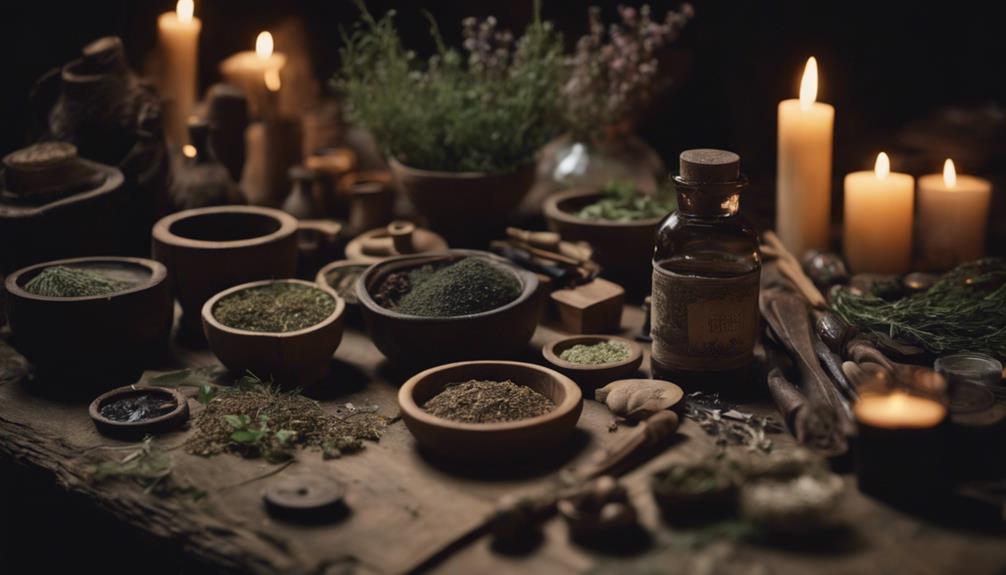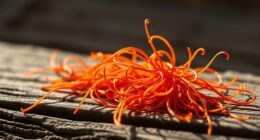To build your home apothecary, start by selecting versatile herbs like dandelion root, milk thistle, lavender, and chamomile for various health needs. Gather essential tools such as mortar and pestle, drying racks, glass jars, and strainers for herb preparation and storage. Safety gear and labeled containers help maintain safety and organization. Exploring resources and connecting with herbalists further enhances your collection. Keep going to discover more tips for creating a well-rounded herbal toolkit.
Key Takeaways
- Select versatile herbs like dandelion root, milk thistle, lavender, and chamomile for multiple health benefits and calming effects.
- Use proper drying, storage, and preservation techniques with airtight containers to maintain herb potency year-round.
- Equip your apothecary with essential tools such as mortar and pestle, scissors, strainers, and glass bottles for preparation and extraction.
- Prioritize safe and durable materials for tools and storage, like non-porous ceramics, glass, and airtight containers.
- Connect with herbalists through online forums and resources to expand plant knowledge and refine your herbal techniques.
Top Herbs for a Well-Rounded Herbal Collection
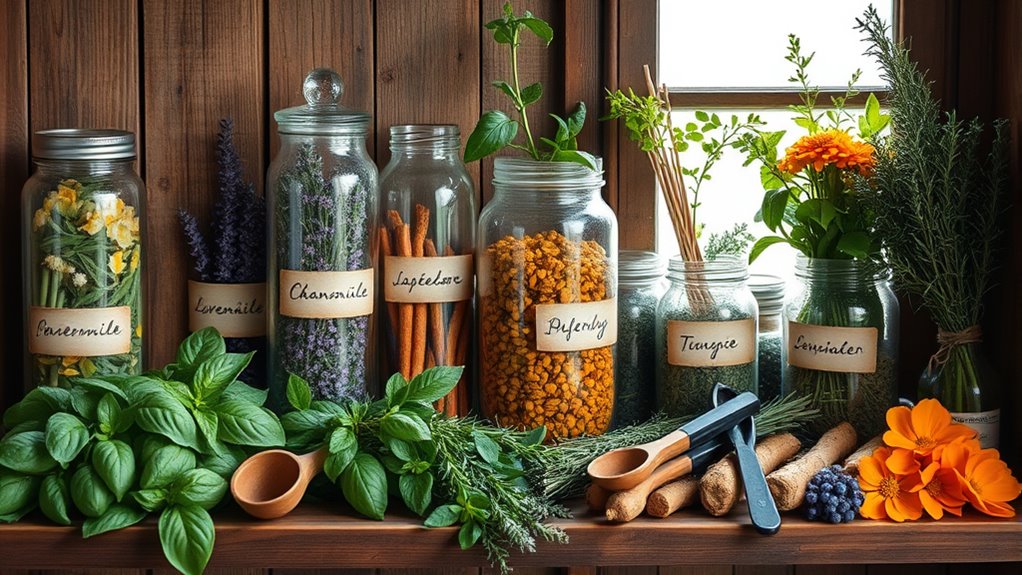
Building a well-rounded herbal collection starts with choosing versatile herbs that can address a variety of health concerns. Focus on herbs like dandelion root and milk thistle for herbal detox, helping your body naturally cleanse. Incorporate herbs such as lavender and chamomile to create calming aromatherapy blends that promote relaxation and reduce stress. These herbs serve multiple purposes and can be used in teas, tinctures, or essential oils. Adding herbs with broad applications guarantees your collection remains practical and adaptable. You’ll find that selecting herbs with diverse uses allows you to craft remedies for digestion, immunity, or mood support. Including herbs known for their metabolic benefits can further enhance your wellness toolkit. Building this foundation empowers you to explore further herbal remedies and customize your remedies for personal wellness.
Essential Dried Herbs and Fresh Options
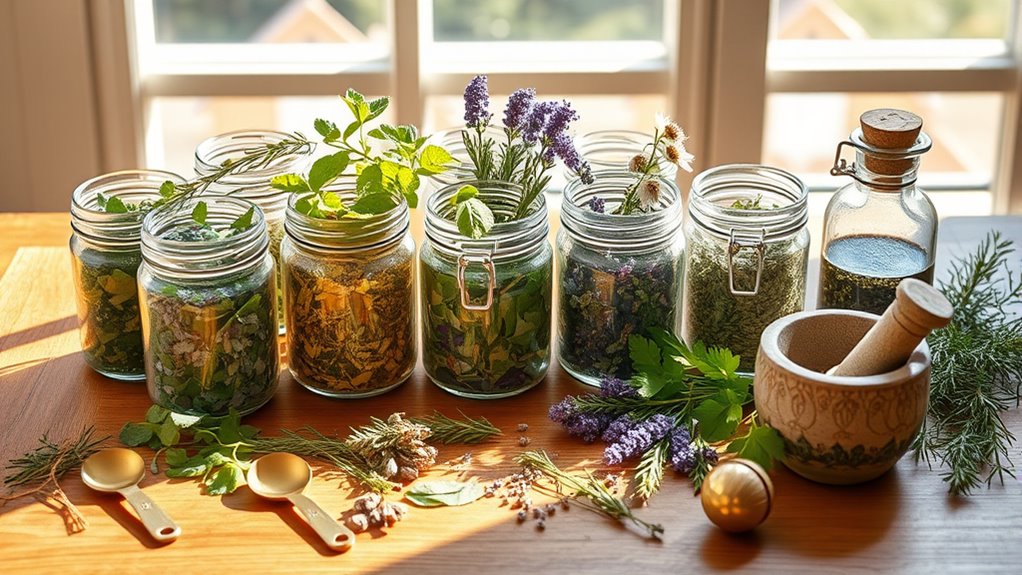
Having a selection of essential dried herbs and fresh options is crucial for maintaining a versatile home apothecary. Herb drying allows you to preserve herbs at their peak potency, guaranteeing you have access to useful ingredients year-round. Dried herbs are perfect for teas, poultices, and herbal tinctures, which extract medicinal properties efficiently. Proper drying methods help maintain herb potency and prevent mold or spoilage. Additionally, understanding how to analyze competitor strategies can help you select the most effective herbs and tools to include in your collection. Properly drying herbs not only preserves their nutritional value but also ensures they retain their medicinal qualities over time. To further enhance your apothecary, consider researching herb expiration signs to know when herbs have lost potency or become unsafe for use. Incorporating herbal preservation techniques can also extend the shelf life of your dried herbs and maintain their effectiveness.
Basic Equipment for Herb Preparation and Storage
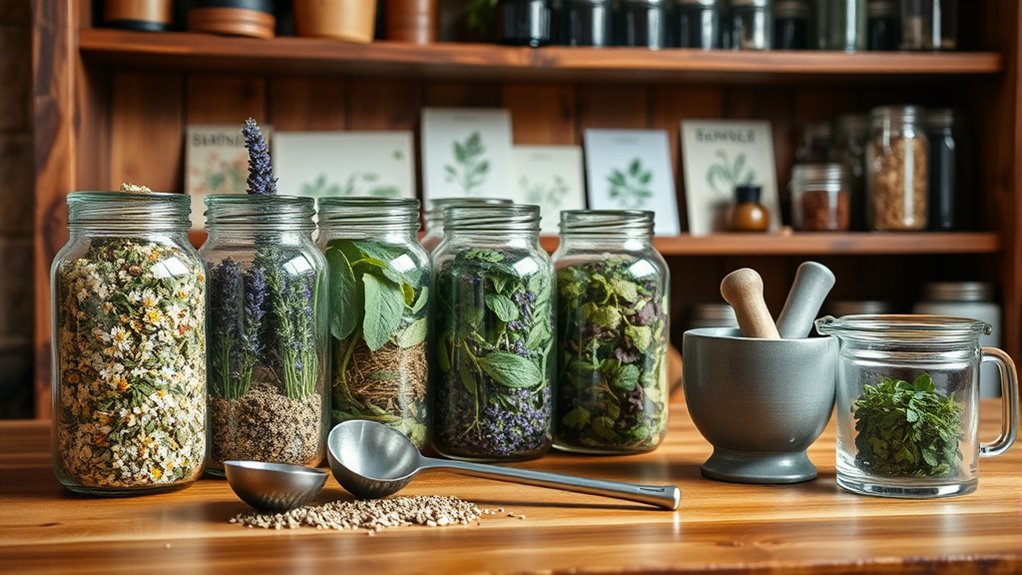
To effectively prepare and store herbs, you need the right tools to handle them properly from harvest to preservation. Basic equipment includes drying racks or screens for herb drying, which help air circulate around the herbs and prevent mold. Sharp knives or scissors are essential for harvesting and trimming herbs efficiently. Glass jars and airtight containers are perfect for storing dried herbs, maintaining freshness and potency. For tincture making, you’ll need clean glass bottles or dropper bottles, along with strainers or cheesecloth to filter the herbs. A mortar and pestle can also be useful for breaking down herbs before drying or tincture extraction. With these tools, you guarantee your herbs are prepared correctly, preserved longer, and ready for use in your home apothecary.
Selecting the Right Mortar and Pestle

Choosing the right mortar and pestle depends on the materials and size you need for your herbs. Different materials, like marble or ceramic, affect how well you grind and preserve flavors. Consider how portable you want your tools to be, especially if you plan to move or store them frequently. Additionally, selecting a suitable size can make your herb preparation more efficient and comfortable. When selecting your tools, also think about the automation of your process, as some materials may require more manual effort than others. Being aware of environmental considerations, such as how the materials impact sustainability, can also guide your choice. Moreover, understanding the AI security vulnerabilities associated with different materials can help you choose tools that are more durable and less prone to damage over time. Incorporating best practices for cleaning can help prolong the lifespan of your mortar and pestle, ensuring safe and effective herb grinding.
Material Choices Matter
The material you select for your mortar and pestle can substantially impact how effectively you grind herbs. Material durability determines how well it withstands frequent use, while aesthetic considerations influence how it complements your space. For example, stone options like granite offer long-lasting performance and a classic look, but ceramic versions may chip over time. Consider the following:
| Material | Durability | Aesthetic Considerations |
|---|---|---|
| Granite | Very durable | Natural, rustic look |
| Ceramic | Moderate, prone to chipping | Elegant, smooth finish |
| Marble | Durable, but softer | Luxurious appearance |
| Wood | Less durable, needs care | Warm, traditional style |
Additionally, understanding the material properties can help you choose a mortar and pestle that best suits your grinding needs and maintenance preferences. Recognizing that some materials, like ceramic, may require more careful handling can help prevent damage and prolong their usability. For instance, the porosity of certain materials can affect how easily they absorb flavors or residues, influencing your cleaning routine. Moreover, selecting a material with a non-porous surface can make cleaning easier and improve hygiene, especially when switching between different herbs. Selecting the right material can also influence the ease of cleaning, which is important for maintaining hygiene and longevity.
Size and Portability
Selecting the right size and portability for your mortar and pestle depends on how you plan to use it. If you often work with small quantities of herbs or spices, a compact design is ideal, saving space and making storage easier. For those who prefer to carry their tools on the go or keep a small home setup, choose a lightweight, portable mortar and pestle that fits conveniently in your storage space. Consider whether you want a set that’s easy to move or one that stays fixed on your countertop. Smaller options are perfect for precision grinding, while larger ones handle bulkier tasks. Prioritize a design that offers both sturdy performance and easy storage, ensuring your tool suits your needs without cluttering your workspace. Additionally, selecting a size that aligns with your typical herb or spice quantities can improve efficiency and reduce waste. Understanding vibrational energy can also help you choose tools that resonate with your intentions and enhance your herbal preparations. Being mindful of environmental impacts when selecting your tools can further support sustainable practices in your home apothecary. Incorporating ergonomic design features can also make your grinding process more comfortable and efficient over time.
Glass Jars and Bottles for Preserving Remedies

Glass jars and bottles are essential tools in your home apothecary, providing a safe and airtight environment to preserve your herbal remedies. They protect your herbal skincare products from light and air, maintaining their potency longer. These containers are versatile for storing tinctures, infusions, and salves, ensuring your remedies stay fresh and effective. When it comes to herbal culinary uses, glass jars make it easy to organize dried herbs, spices, and infused oils, enhancing your kitchen’s efficiency. Plus, their transparency allows you to quickly identify contents and monitor levels, reducing waste. Choosing the right size and shape of jars ensures ideal storage and easy handling. Overall, investing in good-quality glass containers supports your herbal projects, whether for skincare or cooking.
Tools for Infusing and Extracting Potions

Choosing the right infusion equipment can enhance your herbal preparations and improve extraction efficiency. Different tools and methods, like simmering or cold infusion, offer varied results and flavors. Understanding these options helps you craft potent remedies tailored to your needs. Using self-watering plant pots as a model, selecting equipment that maintains consistent conditions can lead to better herbal extraction outcomes. Additionally, selecting machines with advanced technology and design can optimize your infusion process and ensure better quality extracts.
Infusion Equipment Choices
When it comes to infusing herbs and extracting potent essences, the right equipment can make all the difference. You’ll need glass jars or bottles for tincture bottling, guaranteeing they’re airtight and dark-colored to protect the extract. For herb drying, a mesh rack or drying screen helps you air dry herbs evenly, preventing mold and preserving potency. A fine-mesh strainer or cheesecloth is essential for removing plant material from infused liquids. Consider a double boiler or slow cooker for gentle heat infusion if you prefer warm methods. A funnel helps you transfer liquids without spills, and storing your infused herbs and tinctures in labeled, airtight containers keeps your apothecary organized. Choose quality, durable tools to ensure your infusions are safe, effective, and long-lasting.
Extraction Method Variations
Different extraction methods require specific tools to maximize their effectiveness. For herb maceration, you’ll need glass jars or stainless steel containers to gently soak herbs in oils or alcohol. When performing alcohol extraction, precise tools like graduated droppers and fine strainers help you measure and filter extracts cleanly. These tools guarantee maximum potency and clarity in your finished products. Using proper equipment minimizes contamination and preserves the integrity of your herbal infusions. For more advanced techniques, consider a double boiler or slow cooker to control temperature during extraction, especially for delicate herbs. Mastering these tools allows you to customize your infusions based on desired potency and shelf life, making your home apothecary both efficient and sophisticated.
- Glass jars and stainless steel containers
- Graduated droppers and fine strainers
- Double boiler or slow cooker
Essential Utensils for Herb Processing

To process herbs effectively, you need a set of essential utensils that streamline your work and preserve the herbs’ potency. For herb drying, a well-ventilated space with mesh trays or drying racks helps prevent mold and ensures even drying. Sharp scissors or herb scissors make harvesting and trimming easier, reducing damage to the plant. A mortar and pestle allow you to gently crush herbs for herbal tinctures or teas, releasing their active compounds. Glass jars with airtight lids are perfect for infusing herbs in alcohol or oil, maintaining freshness. A fine-mesh strainer or cheesecloth helps strain herbal tinctures without debris. Investing in quality utensils ensures you work efficiently and retain the maximum potency of your herbs throughout your home apothecary process.
Safety Gear and Storage Solutions

When working with herbs, you need to prioritize safety by wearing protective gear like gloves and eye protection to avoid irritation or accidents. Proper storage practices, such as labeled jars and secure containers, keep your herbs fresh and prevent spills or mix-ups. Taking these precautions helps create a safe and organized home apothecary environment.
Protective Equipment Essentials
Protective equipment is essential for guaranteeing your safety while working with herbs and tools in your home apothecary. Using personal protective gear helps prevent accidents and exposure to irritants. Always follow safety protocols to minimize risks during preparation and storage. Invest in quality safety equipment such as gloves, goggles, and masks to shield your skin, eyes, and respiratory system from herb dust, oils, or accidental splashes. Proper protective gear also includes sturdy aprons and well-ventilated workspace setups. Incorporating these items into your routine ensures a safer environment and promotes responsible herbal handling. Remember, safety is a priority in building a reliable home apothecary, so don’t overlook the importance of essential protective equipment. Staying prepared keeps your herbal practices both effective and safe.
Secure Storage Practices
Ensuring your herbs and tools are stored securely is essential for maintaining safety and preserving their potency. Proper herb storage keeps your herbs fresh and prevents accidental ingestion or spills. Use airtight containers made of glass or metal, and label them clearly for easy identification. Container cleanliness is vital; regularly clean storage jars to prevent mold, pests, or cross-contamination. Store herbs in a cool, dark place away from direct sunlight, heat, and moisture, which can degrade their quality. Keep tools in a dedicated, organized space to avoid clutter and accidents. Securing your storage solutions minimizes risks, maintains herb potency, and keeps your home apothecary safe and efficient. Proper storage practices are key to long-term herb preservation and safety.
Calendars and Labels for Herb Management

Have you ever struggled to keep track of your herbs’ planting and harvesting schedules? Using well-organized calendars and clear labels can simplify herb management. Proper herb labeling ensures each plant is easily identified and reduces confusion, especially when storing multiple herbs. A dedicated calendar helps you plan planting, watering, and harvesting times, preventing missed opportunities or overharvesting. To enhance your system, consider:
- Color-coded labels to differentiate herbs by type or stage
- A seasonal calendar to track ideal planting months
- Labels with planting or harvest dates for quick reference
These tools enable precise calendar organization, making your home apothecary more efficient and enjoyable. With consistent herb labeling and a clear schedule, you’ll maximize your herbs’ health and your gardening success.
Resources for Expanding Your Apothecary Collection

Expanding your apothecary collection becomes easier when you explore a variety of resources designed to support your growth. Books and online courses on herbal tincture techniques can deepen your understanding of extraction methods and potency. Local herb workshops or community gardening groups offer hands-on experience and organic gardening tips, helping you grow your own herbs sustainably. Seed catalogs and nurseries provide diverse plant options, while herb identification apps ensure you select the right plants. Connecting with experienced herbalists through forums or social media broadens your knowledge base. These resources enable you to refine your techniques, expand your plant variety, and maintain a sustainable supply, making your home apothecary more versatile and self-sufficient.
Frequently Asked Questions
How Do I Choose Herbs Suitable for My Specific Health Needs?
To choose herbs suitable for your health needs, start by identifying your specific concerns and researching herbs known for their herb potency in addressing those issues. Consult with a healthcare professional or herbalist to create personalized herbal blends that suit your body’s unique response. Trust your intuition, and always start with small doses to observe how your body reacts. This approach guarantees safer, more effective herbal support tailored just for you.
What Are the Best Practices for Sustainable Herb Harvesting?
You should practice sustainable herb harvesting by following wildcrafting ethics and seasonal harvesting. Always obtain permission if needed, avoid overharvesting, and leave enough for the plant to regenerate. Harvest during the plant’s peak season for potency and health. Use selective cutting, taking only what’s necessary, and leave roots intact when possible. This approach helps preserve ecosystems, guarantees future growth, and maintains healthy, thriving herb populations.
How Can I Prevent Contamination During Herbal Preparation?
To prevent contamination during herbal preparation, you must be vigilant from the start. Use proper sterilization techniques on all tools and containers, ensuring they’re thoroughly cleaned and sanitized. Be aware of contamination sources like unwashed hands or contaminated surfaces. By maintaining a clean workspace and practicing good hygiene, you guard your herbs against unseen dangers, preserving their potency and safety. Don’t let contamination sneak in—stay vigilant and prepared.
What Are the Most Cost-Effective Tools for a Beginner Apothecary?
You should start with budget-friendly tools like a basic beginner herbal kit, which includes essential items such as small jars, a mortar and pestle, and a fine mesh strainer. These are affordable and versatile, perfect for learning. Look for multi-use tools that can serve different purposes. You don’t need expensive equipment upfront; focus on quality, affordability, and expanding your toolkit as you gain experience.
How Do I Identify and Troubleshoot Common Herb Storage Issues?
You identify herb storage issues by checking for discoloration, which signals loss of potency or mold. Troubleshoot by ensuring your storage containers are safe—airtight and opaque to protect herbs from light and humidity. Regularly inspect herbs for signs of spoilage, and keep your storage area cool, dry, and clean. Proper containers and routine checks help maintain herb quality and prevent discoloration and other storage problems.
Conclusion
Building your home apothecary is easier than you think—until you realize how many herbs, tools, and labels you’ll want to collect. Just when you thought it was simple, you’ll be hooked on perfecting your remedies and expanding your stash. So, enjoy the chaos and let your herbal obsession grow. After all, who needs just a few herbs when you can have a full-blown, beautifully organized apothecary filled with endless possibilities?




